The Temptations, Afterwards (1988–89).
Elsewhere on { feuilleton }
• The fantastic art archive
A journal by artist and designer John Coulthart.
Art
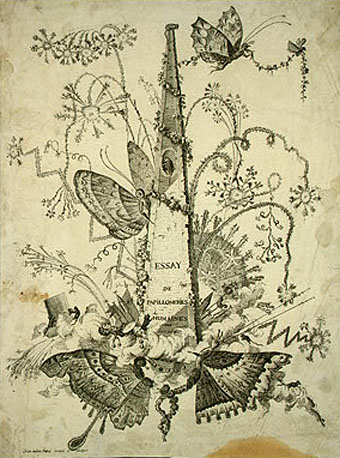
Titre.
Charles-Germain de Saint-Aubin (Paris 1721–86) was one of three famous artist brothers. He worked as a designer for fabrics and textiles, and held the position of dessinateur du Roi to Louis XV. He made twenty-seven etchings, of which the best-known are two sets of six plates from around 1750 entitled Essay de Papilloneries humaines, one horizontal and one vertical in format, in which butterflies act as humans. Earlier designs show animals such as monkeys masquerading as humans, but this seems to be the only time that butterflies appear.
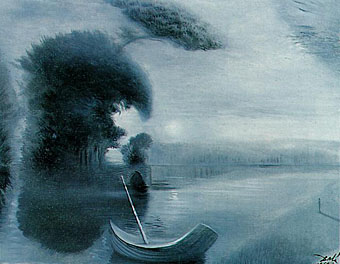
Metamorphosis of Hitler’s Face into a Moonlit Landscape with Accompaniment (1958).
Impressions de la Haute Mongolie (1976/Salvador Dali/José Montes-Baquer/Germany)
In any list of films I’d currently most like to see but can’t due to lack of availability, this bizarre “documentary” collaboration between Salvador Dalí and José Montes-Baquer would be near the top of the list. I saw it once, probably shortly after it had been made, when the BBC screened it as part of their Omnibus arts series in the late seventies. By this time I was already very familiar with the Surrealists, Dalí, Magritte and Max Ernst especially, so it was great to see Dalí himself declaring a supposed mission to explore Upper Mongolia in a search for giant hallucinogenic mushrooms. This premise aside, I remember few other details, the whole film was as delightfully confusing as might be expected. The most distinct memory was of the painting above being shown, then the camera pulling back some distance to reveal the full extent of Hitler’s face which is only hinted at in the original. Happily, a web review now provides us with some more details:
Homage to Impressions d’Afrique (1909), is a free-associative poem written by Raymond Roussel (1877-1933), even though he never visited Africa. The film is dedicated to this French author, forefather of the Surrealists, who developed a formal constraint system to generate inspiration from dislocative puns.
Dalí does the very same thing with this chimerical pseudocumentary leading us to the mysterious realm of High Mongolia where a gigantic white soft mushroom grows, many times more hallucinogenic than LSD! From his studio-museum in Cadacès (Spain), he proceeds to report on the alleged scientific expedition sent out by himself to retrieve this precious treasure, with newspaper clips and newsreel. Childhood memories (like the picture above) are the opportunity to explain more thoroughly the source of his inspiration. This bucolic landscape is in fact a close up of Hitler’s portrait (his nose and moustache) turned to the side!
Wholly Dalíesque, this film experiment pieces together astonishing combinations of superimposed images, fading in and out, switching scale with odd perspectives. Dalí invents a filmmaking process and applies his very language to cinematic purposes, bending the rules to serve his desperate need for originality. Travelling through a microscopic close up of paintings or rough surfaces, his voiceover commentary gives sense to the landscapes taking form under his eyes.
Impressions of Africa was also the title of a Dalí painting from 1938, of course:

It’s probably too much to hope that this will turn up on TV again, so for now I suppose I’ll have to look forward to it appearing on DVD at some point in the future. How about it José?
Update: Ubuweb has a copy!
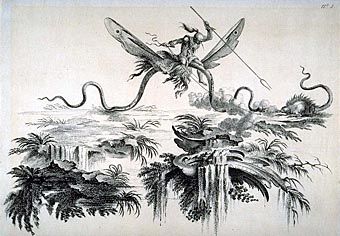
It’s a shame there isn’t more of this imaginative work from Filippo Morghen (1730–1777). In a series of etchings from around 1766 he presents the moon as a tropical world inhabited by the 18th century conception of New World savages. I especially like the hunter on his winged serpent (above) and the elaborate trap set to behead a wary beast (below). The explanatory text is from this print collection which also has large copies of the pictures.
Filippo Morghen was a member of a large family of artists. His brother Giovanni was a painter and printmaker and his son, Rafaello, was a printmaker who specialized in reproductive prints after Raphael and Leonardo. Filippo himself was a designer and printmaker. In addition to the present series on the theme of a voyage to the moon, Morghen is known for a series of plates detailing antiquities from Herculaneum and for views of the environs of Naples.
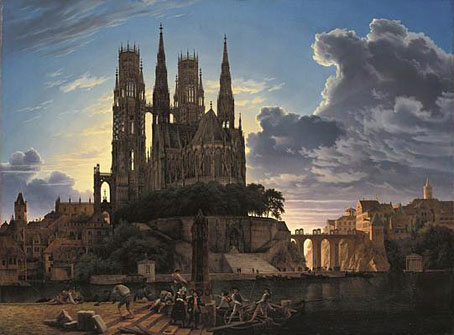
Cathedral Towering over a Town (1813).
Karl Friedrich Schinkel was a German painter and Neo-Classical architect. These paintings, produced early in his career, strongly resemble those of his contemporary Caspar David Friedrich, using landscape as a metaphor and with a similar attention to the quality of natural light. Apparently Schinkel thought too much of the resemblance; after seeing Friedrich’s Monk by the Sea he decided he could never equal Friedrich’s mastery and so concentrated solely on architecture. The picture below of the Queen of the Night is a design for Mozart’s The Magic Flute. Mercury Rev used the painting on the cover of their Secret for a Song single.
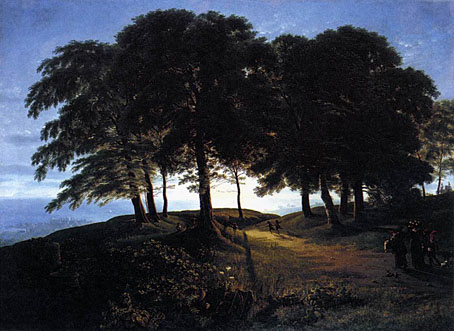
Morning (1813).
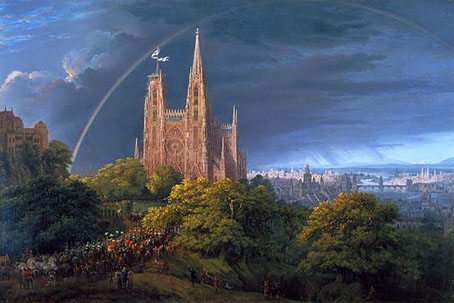
Medieval City on a River (1815).
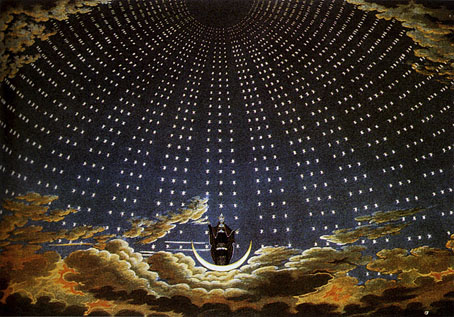
The Queen of the Night (1816).
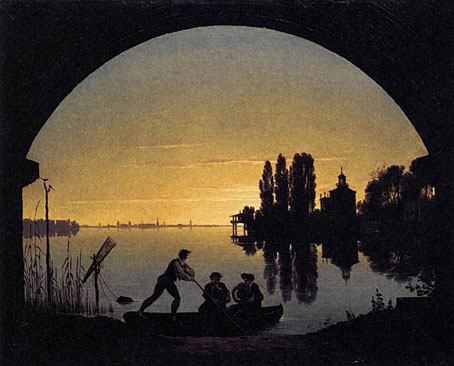
The Banks of the Spree near Stralau (1817).